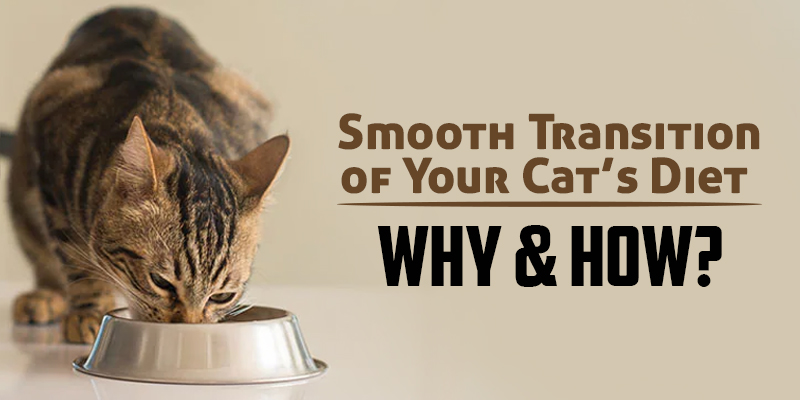How to Smoothly Transition Your Cat’s Diet

Your kitten is growing, you want to try a different brand or flavor, or you want to switch to a special diet to address health issues; anything can be a reason to change your cat’s diet. It is always best to bring such changes gradually.
Cats are creatures of habit, they like routines, and any changes in that can cause a lot of distress to them. Regardless, if you need to change their diet as demanded by a situation, the introduction can be challenging. In this blog, we’ve discussed the importance of changing your cat’s food and described why & how you should do it.
Why Change Your Cat’s Diet?
- With age, the nutritional demands of your cat change. As a kitten, they are more active and thus need more calories and nutrients that benefit their growing bodies. As they age, the need for calories and nutrients changes. Adult cats will need a diet rich in nutrients that supports their health. Senior cats might have decreased physical activity, so they need lesser calories and different nutrients. They need diets that can support their immune system, joint health, and more.
- To maintain the optimum weight of your cat, you need to bring a change in their diet. This includes increasing calorie intake if they are underweight or reducing calories if the feline is overweight. Check with your veterinarian to determine the daily caloric requirement of your cat according to age, weight, and breed.
- If you’re feeding your feline only dry or wet food, you might feel the need to change their diet. Dry food contains more calories and lesser water content than wet food, so choose the right option according to your cat’s requirements. You can select dry food, wet food, or a combination of both.
- Apart from age, weight and nutritional requirements, certain health conditions also require a change in diet. For instance, if your cat has food allergies, has a sensitive stomach, or has dry & itchy skin; giving them food that accommodates their needs should be a priority.
Sometimes the need to change their diet can be simply because they don’t like the current food you serve them, then you can switch to something you think they might prefer eating.
[Also Read] Unveiling the Little-Known Ways of Cat Health Care
Important factors to note while changing your cat’s diet
The key to changing your cat’s diet is patience. Being patient with your cat, giving them time to adjust to the change and gradual introduction is crucial for succeeding in the task. Experts recommend that the transition should occur between 7 to 10 days; it can vary with the cat’s personality. Moreover, a slow transition helps your cat adapt to the new food easily and prevents indigestion and rejection of new flavor and texture.
Here’s a rough guide you can follow to switch your cat’s diet without causing them distress:
Days 1-2: Feed your feline a mixture of 75% old food and 25% new food
Days 3-4: Combine 50-50% of each food
Days 5-6: Switch to 25% old food and 75% new food
Day 7: In most cases, you can start feeding the new food exclusively.
When making a changeover, ensure that your cat is readily accepting the mixtures of food, if you feel that they are rejecting any of the combinations, then reduce the amount of new food and try again. Some cats might take longer, so don’t get discouraged! Be patient and do not rush the transition; never skip a step or make changes in their diet too fast. This can result in rejection and you might have to start anew.
Tip: Drizzle some tuna juice or fish oil over the food. You can also mix in their favorite treats with the new food to ease the transition. Try different textures till you find the one your cat likes the most.
Rotational diets
Starting from a young age, you can try rotational diets, which will ensure that your cat does not get hooked to a single flavor or texture. Try changing the food daily, weekly, bi-weekly, or monthly. With the constant change in the food, your cat will not be distressed when fed a different formula.
Bottom Line
As all cat parents know, cats are creatures of routine and dislike changes. So, for a smooth transition, it is imperative to understand their behavior and let them dictate the speed of changeover. With time, patience, and lots of love your kitten will learn to enjoy the new food! Simply watch out for digestive upsets. It can be a sign that the transition happened too quickly; try slowing down and give it a gradual approach. You can also talk to your veterinarian for a piece of advice for a smooth switch.

David joined CanadaVetCare in 2013 as a product analyst and veterinary assistant. Being a passionate pet lover and keen animal health researcher, David had always found ways and solutions to help pet parents to improve their pets’ health. He is always happy to answer pet health-related queries and recommending pet parents for the right pet product for their furry companions.

